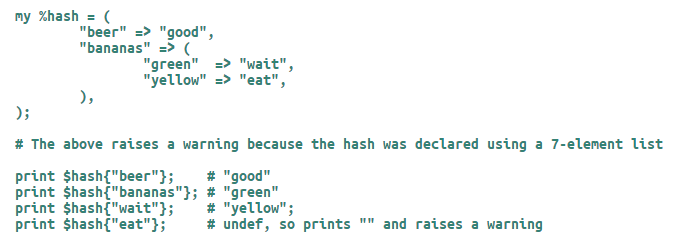我觉得这一系列的标题应该是:PERL,从入门到放弃
USE IT OR U WILL LOSE IT
参考资料:
https://qntm.org/files/perl/perl.html
在线perl编译器:
https://www.tutorialspoint.com/execute_perl_online.php
use strict; use warnings; # no block comments # variables: use 'my' for declaration # 1. scalars: undef(like NULL), number, string, reference to any other variables # no distinguish between float and int my $num = 12.34; # use '.' for string concatenation my $str = "hello, "."m'lady"; print $str." "; # no boolean type. but "false" in condition means: 0,"","0",undef # 2. arrays: use @variableName # trailing comma is OK my @arr = (1, "hi", 3,); # use '$' because it's scala when retrived print $arr[0]." "; # negative index means retriving from backend print "$arr[-2] "; # '' will not interpret, just output raw string # "" will interpret variables # they're same: print 'Hello $str @arr' print "Hello $str @arr" # OPERATORS # Numerical operators: <, >, <=, >=, ==, !=, <=>, +, * # String operators: lt, gt, le, ge, eq, ne, cmp, ., x
啦啦啦今天继续啊
数组长度:
my @arr = (2, "Hi", "my", "lady", "!"); # the length of array print scalar @arr; print " "; # the end index of array. aka, length-1 print $#arr;
- hash Tables:
use strict;
use warnings;
# hash variable
my %hashTable = ("1st" => "hi",
"2nd" => "my",
"3rd" => "lady");
# since some element is a scalar
print $hashTable{"1st"};
use strict;
use warnings;
my %hashTable = (1=>"hi", 2=>"my", "3rd"=>"lady");
# convert to array
my @arr = %hashTable;
# 1hi2my3rdlady
print @arr;
# output 1
print $arr[0];
# 索引时hash用{},array[],""有无无所谓;构建时两者都用()
#print $hashTable{1};
#print $hashTable{"1"};
- list
列表指的是用()构建的东西,array和hash都是。列表可以作为一个元素放在列表中间,但是会失去层次结构。hash的话,

use strict;
use warnings;
my @array = (
"apples",
"bananas",
(
"inner",
"list",
"several",
"entries",
),
"cherries",
);
my $i = 0;
while ($i <= $#array) {
print "array[$i] is ".$array[$i]."
";
$i = $i + 1;
}

但其实list与array还是不同的,如下例:
my @arr = ("alpha", "beta", "gamma", "pie");
# 这里得到arr的长度
my $num = @arr;
print "$num
";
# output: pie $num1存的是最后一项
my $num1 = ("alpha", "beta", "gamma", "pie");
print "$num1
";
Every expression in Perl is evaluated either in scalar context or list context
而对很多函数来说,对scalar和list的处理方式是不同的,如reverse:
# link. no reverse print reverse "hello, my lady", 3, " "; print " "; # reverse each letter my $scalar = reverse "hello, my lady"; print "$scalar ";

可以在前面强制加scalar,让函数可以按照scalar的方式处理:
print scalar reverse "hello world"; # "dlrow olleh"
而在下面的例子中,给$outer[3]赋值时,由于它是scalar,所以取得的值只能是数组长度,而非数组。
my @outer = ("Sun", "Mercury", "Venus", undef, "Mars");
my @inner = ("Earth", "Moon");
$outer[3] = @inner;
print $outer[3]; # "2"
好吧,为了解决这个问题,使用引用:
my $colour = "Indigo";
# add reference
my $scalarRef = $colour;
print $colour; # "Indigo"
print $scalarRef; # e.g. "SCALAR(0x182c180)"
print ${ $scalarRef }; # "Indigo"
# 如果不会混淆,可以省略{}
print $$scalarRef;
my @colours = ("Red", "Orange", "Yellow", "Green", "Blue");
my $arrayRef = @colours;
print $colours[0]; # direct array access
print ${ $arrayRef }[0]; # use the reference to get to the array
print $arrayRef->[0]; # exactly the same thing
my %atomicWeights = ("Hydrogen" => 1.008, "Helium" => 4.003, "Manganese" => 54.94);
my $hashRef = \%atomicWeights;
print $atomicWeights{"Helium"}; # direct hash access
print ${ $hashRef }{"Helium"}; # use a reference to get to the hash
print $hashRef->{"Helium"}; # exactly the same thing - this is very common
我们希望定义自己的数据类型,类似C++里类的概念,所以我们这样做:
# Braces denote an anonymous hash
my $owner1Ref = {
"name" => "Santa Claus",
"DOB" => "1882-12-25",
};
my $owner2Ref = {
"name" => "Mickey Mouse",
"DOB" => "1928-11-18",
};
# Square brackets denote an anonymous array
my $ownersRef = [ $owner1Ref, $owner2Ref ];
my %account = (
"number" => "12345678",
"opened" => "2000-01-01",
"owners" => $ownersRef,
);
注意,这里$owner1Ref和$owner2Ref存的其实是一个匿名hash的引用,$ownersRef存的则是匿名array的引用。既然时候引用,
它们的实际值就是地址。所以%account中才能够保存完整的信息。等价于:
my %account = (
"number" => "31415926",
"opened" => "3000-01-01",
"owners" => [
{
"name" => "Philip Fry",
"DOB" => "1974-08-06",
},
{
"name" => "Hubert Farnsworth",
"DOB" => "2841-04-09",
},
],
);
如何打印?使用->
print "Account #", $account{"number"}, "
";
print "Opened on ", $account{"opened"}, "
";
print "Joint owners:
";
print " ", $account{"owners"}->[0]->{"name"}, " (born ", $account{"owners"}->[0]->{"DOB"}, ")
";
print " ", $account{"owners"}->[1]->{"name"}, " (born ", $account{"owners"}->[1]->{"DOB"}, ")
";